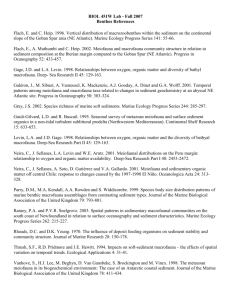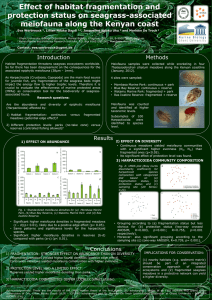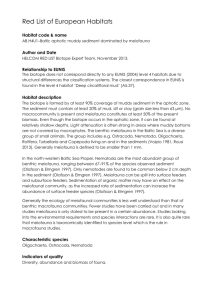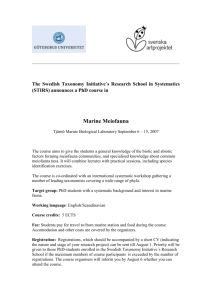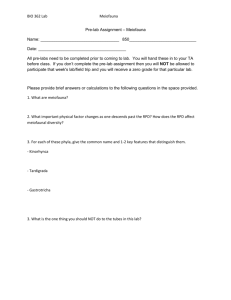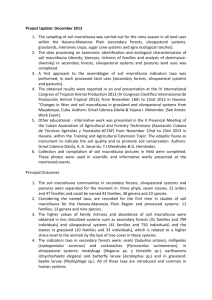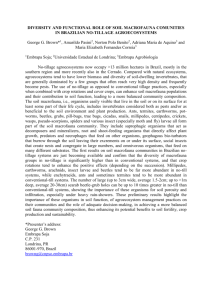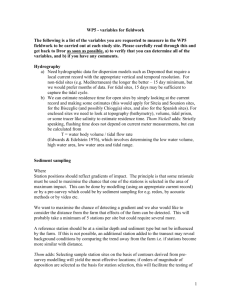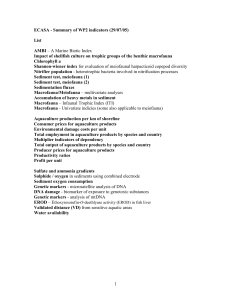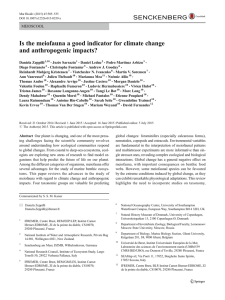Model Summary - Sociedade de Ecologia do Brasil
advertisement
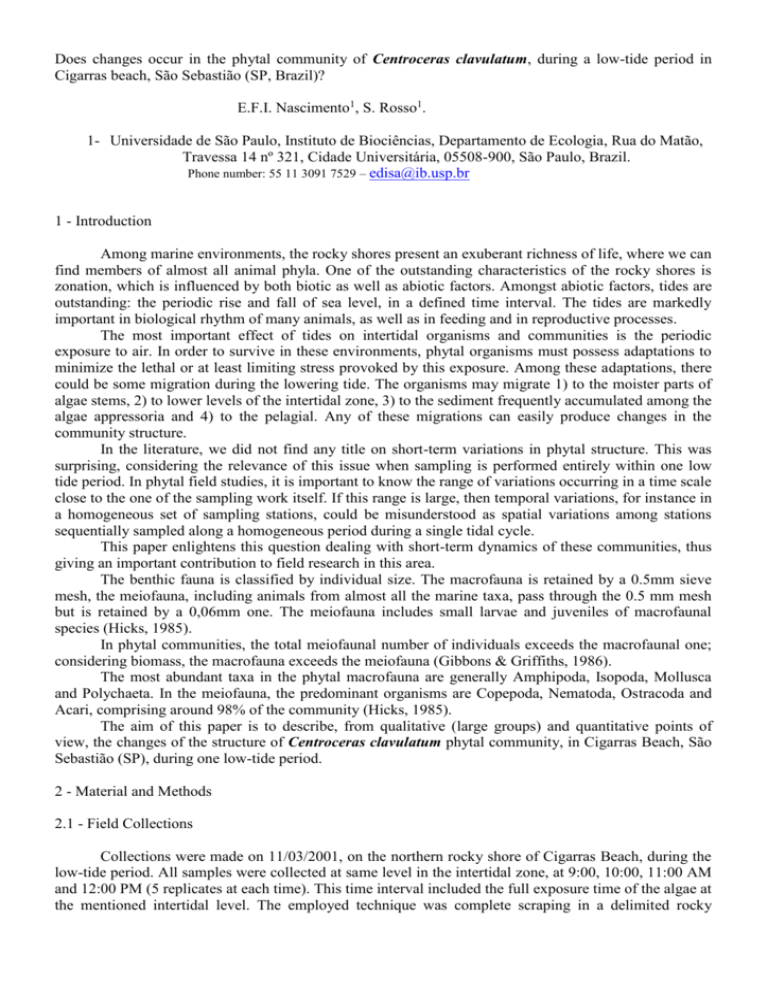
Does changes occur in the phytal community of Centroceras clavulatum, during a low-tide period in Cigarras beach, São Sebastião (SP, Brazil)? E.F.I. Nascimento1, S. Rosso1. 1- Universidade de São Paulo, Instituto de Biociências, Departamento de Ecologia, Rua do Matão, Travessa 14 nº 321, Cidade Universitária, 05508-900, São Paulo, Brazil. Phone number: 55 11 3091 7529 – edisa@ib.usp.br 1 - Introduction Among marine environments, the rocky shores present an exuberant richness of life, where we can find members of almost all animal phyla. One of the outstanding characteristics of the rocky shores is zonation, which is influenced by both biotic as well as abiotic factors. Amongst abiotic factors, tides are outstanding: the periodic rise and fall of sea level, in a defined time interval. The tides are markedly important in biological rhythm of many animals, as well as in feeding and in reproductive processes. The most important effect of tides on intertidal organisms and communities is the periodic exposure to air. In order to survive in these environments, phytal organisms must possess adaptations to minimize the lethal or at least limiting stress provoked by this exposure. Among these adaptations, there could be some migration during the lowering tide. The organisms may migrate 1) to the moister parts of algae stems, 2) to lower levels of the intertidal zone, 3) to the sediment frequently accumulated among the algae appressoria and 4) to the pelagial. Any of these migrations can easily produce changes in the community structure. In the literature, we did not find any title on short-term variations in phytal structure. This was surprising, considering the relevance of this issue when sampling is performed entirely within one low tide period. In phytal field studies, it is important to know the range of variations occurring in a time scale close to the one of the sampling work itself. If this range is large, then temporal variations, for instance in a homogeneous set of sampling stations, could be misunderstood as spatial variations among stations sequentially sampled along a homogeneous period during a single tidal cycle. This paper enlightens this question dealing with short-term dynamics of these communities, thus giving an important contribution to field research in this area. The benthic fauna is classified by individual size. The macrofauna is retained by a 0.5mm sieve mesh, the meiofauna, including animals from almost all the marine taxa, pass through the 0.5 mm mesh but is retained by a 0,06mm one. The meiofauna includes small larvae and juveniles of macrofaunal species (Hicks, 1985). In phytal communities, the total meiofaunal number of individuals exceeds the macrofaunal one; considering biomass, the macrofauna exceeds the meiofauna (Gibbons & Griffiths, 1986). The most abundant taxa in the phytal macrofauna are generally Amphipoda, Isopoda, Mollusca and Polychaeta. In the meiofauna, the predominant organisms are Copepoda, Nematoda, Ostracoda and Acari, comprising around 98% of the community (Hicks, 1985). The aim of this paper is to describe, from qualitative (large groups) and quantitative points of view, the changes of the structure of Centroceras clavulatum phytal community, in Cigarras Beach, São Sebastião (SP), during one low-tide period. 2 - Material and Methods 2.1 - Field Collections Collections were made on 11/03/2001, on the northern rocky shore of Cigarras Beach, during the low-tide period. All samples were collected at same level in the intertidal zone, at 9:00, 10:00, 11:00 AM and 12:00 PM (5 replicates at each time). This time interval included the full exposure time of the algae at the mentioned intertidal level. The employed technique was complete scraping in a delimited rocky substrate area. Each sample was taken placing a 120 ml pot with a 3.2cm diameter opening (facing down) at the desired level on the Centroceras clavulatum bed, and the area corresponding to the pot opening was scraped with a spatula. Formaldehyde 4% was promptly added to the contents in order to fill the pot. 2.2.- Processing of the collected material Once in the laboratory, each sample was washed in a series of buckets with a solution of formaldehyde in seawater. Each bucket was emptied on a 0.063mm mesh sieve, in order to concentrate the already preserved fauna. Material from each sample was classified in a series of four sieves (0.50, 0.25, 0.12 and 0.06 mm) to separate the fauna in different size categories (Pannkuche & Thiel, 1988). The material retained in each one was preserved in formaldehyde 4% and dyed with Bengal Rose. The macrofauna and meiofauna were sorted (the 0.06mm sieve mesh material was sub-sampled to ease counting). All counts for the main taxonomic groups were made with a stereomicroscope, at 20x to 100x. The numbers of individuals were standardized per mg dry weight of the algal fraction of the corresponding sample; samples were dried in an oven, at 100 oC for 24 hours. 2.3 - Data processing At first, exploratory multivariate non-parametric ordination analyses (NMDS) were done with raw as well as with log-transformed data, always based on Bray Curtis distance index. Then, differences in the abundances of large groups, among 3 levels of the factor “sieve” and 4 levels of the factor “time” (for meiofauna), and among 4 levels of the factor ”time” (for macrofauna), were tested using non-parametric multivariate variance analysis NPMANOVA (Anderson, 2000) on logtransformed data, and also using Factorial ANOVA on rank-transformed data (SPSS). The “a posteriori” comparisons were made using the Tukey-HSD test. 3 - Results and Discussion 1674 specimens of the macrofauna and 22.972 of meiofauna, were found in the set of 20 samples. In fact, according to data from literature, the meiofauna surpasses the macrofauna as to number of specimens. For all schedules, the averaged specific proportions showed that the dominant groups were Polychaeta (72.6% at 9:00 AM; 87.22% at 10:00 AM, 56.7 % at 11:00 AM, 45.22% at 12:00 PM) and Bivalvia (16.66% at 9:00 AM, 3.88% at 10:00 AM, 21.77% at 11:00 AM, 29.04% at 12:00 PM). As to the meiofauna, the percentages of several groups were more evenly balanced. At 9:00 AM, the main groups were Bivalvia (54.23%), Nauplii (16.03%), Nematoda (10.76%), Copepoda (10.09%) and Polychaeta (6.37%); at 10:00 AM, they were Bivalvia (46.09%), Polychaeta (16.03%), Nematoda (14.44%), Copepoda (13.81%) and Nauplii (6.29%); at 11:00 AM, they were Bivalvia (58.92%), Copepoda (10.97%), Nematoda (10.46%), Polychaeta (8.52%) and Nauplii (7.16%); and finally, at 12:00 PM, the main groups were Bivalvia (66.85%), Nematoda (9.3%), Nauplii (9.38%), Copepoda (8.5%) and Polychaeta (4.04%). The results presented differ from those commonly found in the phytal of other algae, where generally Amphipoda dominates the macrofauna and Copepoda dominates the meiofauna. The architectural structure of Centroceras clavulatum aggregates is quite different from that of other species of algae from which the phytals have already been described (i.e. some species of Sargassum and Amphiroa). In the case of Centroceras clavulatum the considerable accumulation of sediment on the base of the bundle of filaments could be related to the predominance of Polychaeta and Bivalvia, given that these groups were found in high concentration in the sediment. A study of stratification throughout the low-tide period would clarify whether it is a case of migration to the aggregate base during the period of exposure to the air, or whether these organisms are strictly sediment colonizers. In the case of macrofauna, the exploratory ordination analysis (NMDS) showed very clearly the difference between the first and the second halves of the studied period. Statistical analysis showed at least one significant difference among samples collected at different times during the morning. By the NPMANOVA, there was no distinction between the 9:00 AM and 10:00 AM samples (p=0,2854); those of 11:00 AM and 12:00 PM were distinct (p=0,0474); all differences between each pair of samples, one from the first half of the studied period and other from the second, were highly significant (0,0075<p<0,0081) “Post-hoc” tests employed after processing by ANOVA on ranks indicated Nematoda, Bivalvia and Amphipoda as taxonomic groups which changed their abundances from the first to the second half of the studied period. Gastropoda showed distinct abundance only at 11:00 AM. The remaining groups presented no significant difference throughout the low-tide period. As to the meiofauna, the ordination analysis showed a tendency towards distinction between the middle of the observation period (10:00 AM and 11:00 AM) and the extremes, these latter being similar amongst themselves. Statistically, by NPMANOVA, there was noted at least one significant difference between hours (p=0,0099) and also among the sieve meshes (p=0,00005), with no significant interaction at the 0.05 level (even though the error probability of rejection of the null hypothesis in this case was not to be disregarded: p=0,1494). The corresponding “a posteriori” tests, however, did not reveal any significant differences when hours were compared as pairs. By Factorial ANOVA on ranks, both schedules as well as sieve meshes revealed some significant differences (p= 0,0005). Some faunistic groups (Copepoda, Polychaeta, Turbellaria and Acari) segregated the schedules 9:00 AM / 12:00 PM on one side, and 10:00 AM / 11:00 AM on the other, in agreement with the multivariate result of NMDS. Bivalvia separated the first half from the second half of the period (as observed in macrofaunal groups) 4 - Conclusion It was shown that the temporal variation in the structure of the phytal macrofaunal community of Centroceras clavulatum is mainly due to certain faunistic groups, which appear with different abundances at the beginning and at the end of the exposure period. Although in a different temporal pattern, the meiofauna also presented abundance variation in some groups: in these cases, almost as a rule, a change in abundance at extreme low-tide was apparent, the initial and final phases of the period of exposure to air being similar, suggesting that the abundance change at the beginning of a single exposure period is reversed before it’s end. The response of the macrofauna to exposure seems to be slower and changes are not reversed in the same exposure period. Acknowledgements This paper is part of study of macrofauna and maiofauna of São Paulo University, Ecology Department. A special thanks to CEBIMar and CAPES for financial the project. References Anderson, M.J. 2000. NPMANOVA: a FORTRAN computer program for non-parametic Multivariat Analisis of variance (for any two factor design) using permutation tests. Department of Statics.University of Auckland. In press. Gibbons, M.J. & Griffths, C.L. 1986. A comparison of macrofauna and meiofauna distribution and standing stock across a rocky shore, with an estimate of their productivities. Mar. Biol., 93: 181188. Hicks, G.R.F. 1985. Meiofauna associated with rocky shore algae. In: Moore, P.G. & Seed R., (eds). The ecology Of rocky coasts. London, Hodder & Stoughton, p. 36-56. Pfannkuche, O. & Thiel, H. 1988. Sample processing. In R.P. Higgns & Thiel eds: Introduction to the
